Welcome, ye scurvy landlubbers, to a rum-fuelled edition of Visual Memory! The grog isn’t strictly necessary, but it’s rather fitting for the game Christopher Bell has loaded into the cannons this month. Prepare to set sail for The Secret of Monkey Island!
This classic point-and-click adventure was created by a triumvirate of designers and writers, Ron Gilbert, Dave Grossman and Tim Schaffer, as an alternative to heavy-handed adventure games where one slip meant instant death or inability to complete the game. This was meant to be a more forgiving (there’s only one place you can die, and that’s by drowning), and thus more enjoyable experience.
Players take on the mantle of Guybrush Threepwood, a young scallywag out to prove himself as a mighty pirate on Mêlée Island. To do this he needs to complete three tasks to impress a trio of pirate lords. Along the way, he will meet the love of his life (the governess of Mêlée Island, Elaine Marley), as well as battling the ghost of LeChuck, an infamous pirate out to marry Elaine by any means necessary.
| A duel of wits |
Unfortunately, Guybrush doesn’t cut a very imposing figure and weighs about eight stone soaking wet. But he can hold his breath underwater for around ten minutes, and more crucially, has a razor-sharp and ready wit. This comes in very handy during one of the game’s real highlights – the duelling sequences.
The combatants rely less on actual swordplay (no stabbing each other here, that wouldn’t be funny), and more on impaling each other with sarcastic put-downs. The series’ creators turned to the old Errol Flynn swashbucklers for inspiration, as they did practically the same thing with their action scenes. These duelling mini-games proved so popular they made it into each of the game’s sequels and were even referenced in the Scott Pilgrim comics (“How appropriate! You fight like a cow!”).
 |
| A Disneyland classic |
One of Monkey Island’s other main influences was the Disneyland attraction, Pirates of the Caribbean. This was a childhood favourite of Ron Gilbert, who used the attraction’s themes to give the game more atmosphere. To return the favour, he packed the games with references to the ride, including the famous ‘dog with cell keys’ scene. Players have to get Walt (yes, that’s the dog’s name) to drop the keys by recreating the scene and waving a leg bone in his direction.
The games also borrow heavily from On Stranger Tides, a novel by Tim Powers (and loosely adapted as the fourth Pirates of the Caribbean movie). The supernatural themes here influenced most of the latter half of the game, as well as the main characters.
There’s plenty of creativity to admire behind the scenes as well. The game’s engine was modified from LucasArts’ previous graphic adventures, Maniac Mansion and Day of the Tentacle. The engine was christened SCUMM (Script Creation Utility for Maniac Mansion), which also made development of that same game much easier. This allowed LucasArts to create items, areas and dialogues without having to re-write the underlying code for different gaming systems. In short, the engine could be ported across multiple platforms without breaking a sweat. Monkey Island also features a refined and easy-to-use interface, making the action of the game smoother and more intuitive.
| Funny puzzles are the game’s staple |
The SCUMM engine was so successful that it earned several in-game references. It’s the name of the pirate bar, as well as an item in the rather unnerving list of ingredients of the bar’s grog (which can eat through pewter tankards in seconds).
The Monkey Island series went on to spawn four sequels on various platforms over the next 20 years, as well as Special Edition re-releases of the first two games. These featured new voice overs, new HD graphics (the original sprites were included) and all sorts of extras.
An animated film was commissioned in the late 1990s by Lucasfilm and Industrial Light & Magic, but sadly came to nothing. (I’ve not been able to find a reason for the cancellation, but if anybody knows the truth, please get in touch!) Somewhat ironically, the film’s script was written by Ted Elliot (Aladdin, Shrek) who went on to co-write the Pirates of the Caribbean movies. All that remains of the project today are a few scraps of concept art.
 |
| Concept art from the aborted movie project |
Tim Schaffer went on to produce various cult hits such as Grim Fandango, Psychonauts and Brutal Legend, as well as a Sesame Street Kinect title with his own company, Double Fine. He is now hard at work on a new game – Double Fine Adventure – with fellow Monkey Islander Ron Gilbert. This is the same title that made several million dollars on Kickstarter over the space of a week.
And Guybrush himself? Despite the success of the Special Editions and Tales of Monkey Island (an episodic fifth game), there are no plans to revisit Mêlée Island for now. However, the winds of game development could change direction at any time, and if they do, the good ship Monkey Island will be ready to set sail once again.
 |
| Some more movie concept art |
Game: The Secret of Monkey Island
Developer/Publisher: LucasArts
Platforms: PC, Atari ST, Sega Mega CD, Mac (Re-released on PSN, XBLA and iOS devices)
Year: 1990 – 1993 (Re-release: 2009)
Click here to check out Christopher’s other Visual Memory articles.

